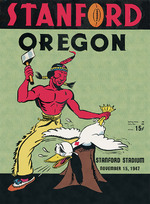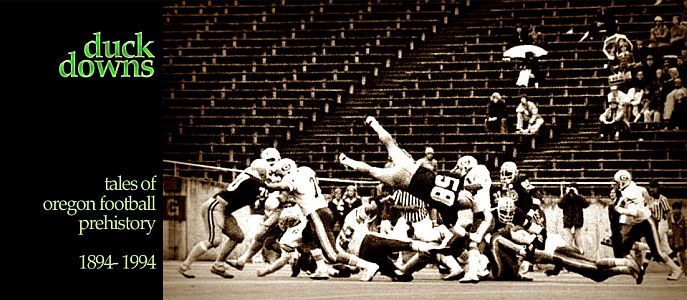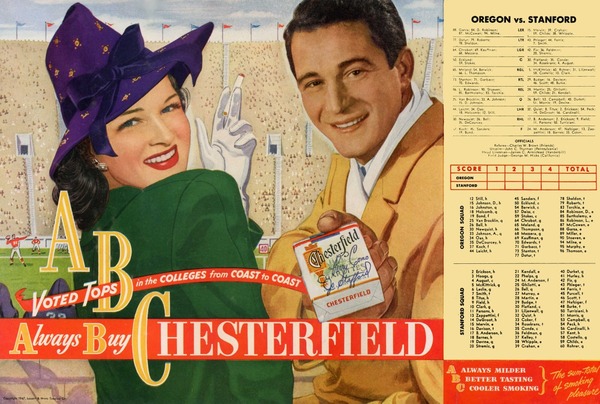« November 15, 1947: Oregon at Stanford »
 February 2, 2012
February 2, 2012  click to embiggenA team’s game program souvenir publication often reflects the personality, ambition and traditions of its publisher. The long-term, well-funded programs for teams with large stadiums and big publication runs carry features like custom cover illustrations (for example, the humorous work by John Churchill Chase for Texas in the mid-20th century), voluminous advertising inches, player biographies, looks at other school sports, and the like. Presumably, the more you can cram into that magazine, the more likely someone will buy it on game day and not leave it laying in shreds under the seats.
click to embiggenA team’s game program souvenir publication often reflects the personality, ambition and traditions of its publisher. The long-term, well-funded programs for teams with large stadiums and big publication runs carry features like custom cover illustrations (for example, the humorous work by John Churchill Chase for Texas in the mid-20th century), voluminous advertising inches, player biographies, looks at other school sports, and the like. Presumably, the more you can cram into that magazine, the more likely someone will buy it on game day and not leave it laying in shreds under the seats.
As a contrast, there is Stanford University’s late-40s program format.
The cover illustration: disgusting, yes, but at least this caricature has an expression of focus and resolve as he aims his hatchet at the duck’s neck; there are many examples of much more humiliating representations of their beloved “mascot.” Stanford would continue humiliating Native Americans in this way until a group of students began agitating in 1972 to recapture a small piece of their own  dignity; that year, the Stanford administration responded to their petition by unilaterally declaring, to its eternal credit, that “any and all Stanford University use of the Indian Symbol should be immediately disavowed and permanently stopped.” Ever since, there have been periodic efforts by nimrod fraternity brothers and alumni to resurrect a “wild-eyed, big-nosed, tomahawk-chopping savage” as the public face of Stanford athletics, as recently as 2006. (The Stanford Review has a good history of the subject.)
dignity; that year, the Stanford administration responded to their petition by unilaterally declaring, to its eternal credit, that “any and all Stanford University use of the Indian Symbol should be immediately disavowed and permanently stopped.” Ever since, there have been periodic efforts by nimrod fraternity brothers and alumni to resurrect a “wild-eyed, big-nosed, tomahawk-chopping savage” as the public face of Stanford athletics, as recently as 2006. (The Stanford Review has a good history of the subject.)
Beyond the cover, the program is itself embarrassingly skimpy for a major college program in a large metropolitan area. It’s only eight pages, including the covers; three of those pages are full-color cigarette ads, with a center spread featuring pop singers Perry Como and Jo Stafford hawking Chesterfields, and a comely back cover cheerleader insisting that Camels are “The Choice of Experience” (think her parents knew?). The four pages of editorial content are limited to head shots of head coaches Jim Aiken and Marchy Schwartz, a roster (admittedly comprehensive), and two pages of player photo collages. No stats. No game stories. No player features.
All this for fifteen cents, of which .004 cents was somehow payable as sales tax.
The game itself, the penultimate contest of Jim Aiken’s first season at the helm, played out on a rainy Saturday before 15,000 fans rattling around in Stanford’s 90,000-seat bowl; presumably most of the game programs were snapped up as emergency headwear, but no rain fell during the game itself. The Webfoots asserted themselves early on the muddy field, surrendering only a late touchdown in a 21-6 victory. “Grandpa” Jake Leicht, the PCC’s leading rusher at 27 years old, and George Bell ran over and around the bigger but slower Stanford defenders – some things never change – and Norm Van Brocklin passed and punted efficiently (and sat out on defense, as usual).
After knocking off OSC the following week, Oregon’s record stood at 7-3, their best season since 1933. With only six seniors on the 1947 roster, things were looking up.
 college football programs in
college football programs in  1947,
1947,  Stanford
Stanford 

Reader Comments